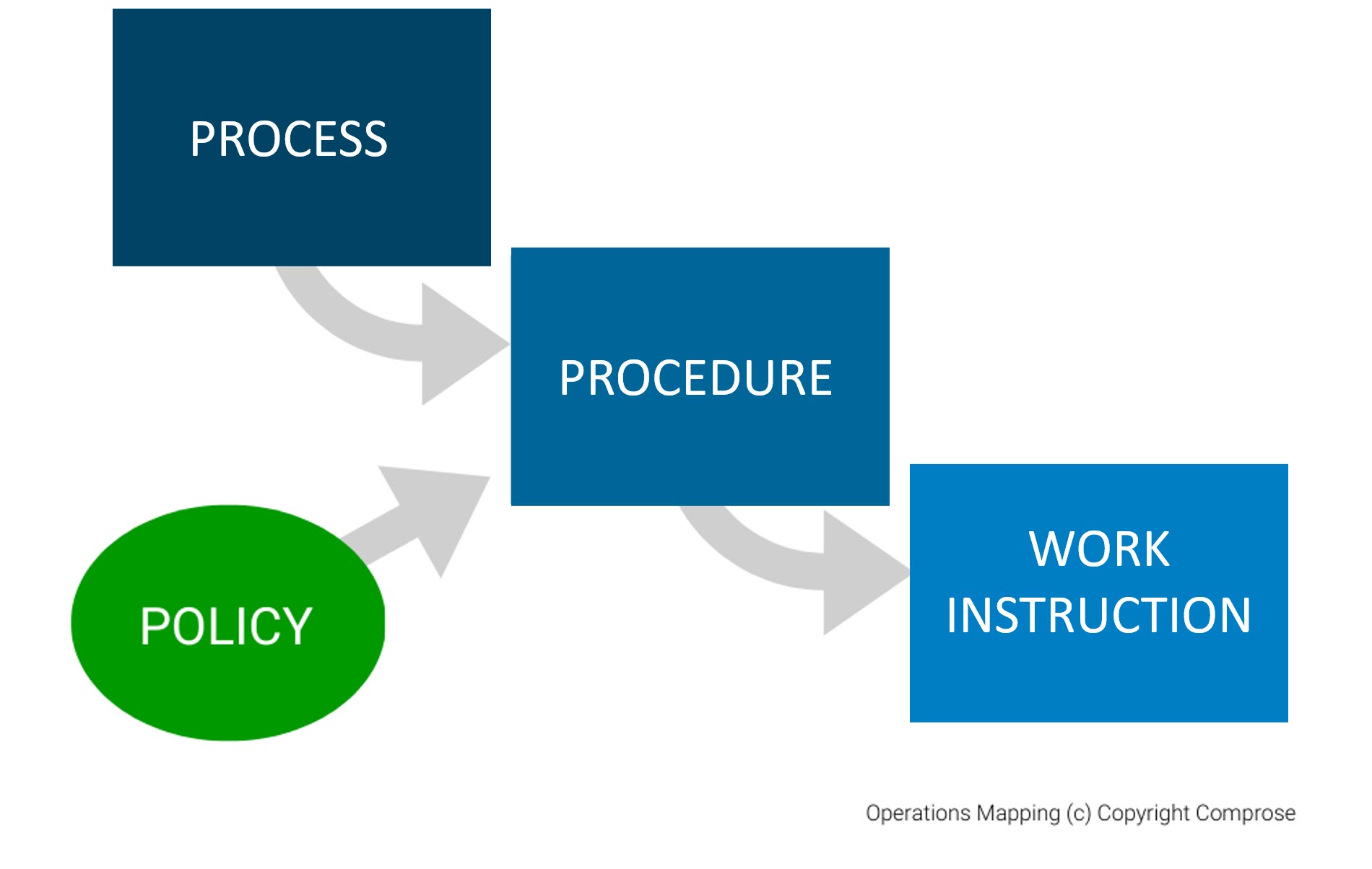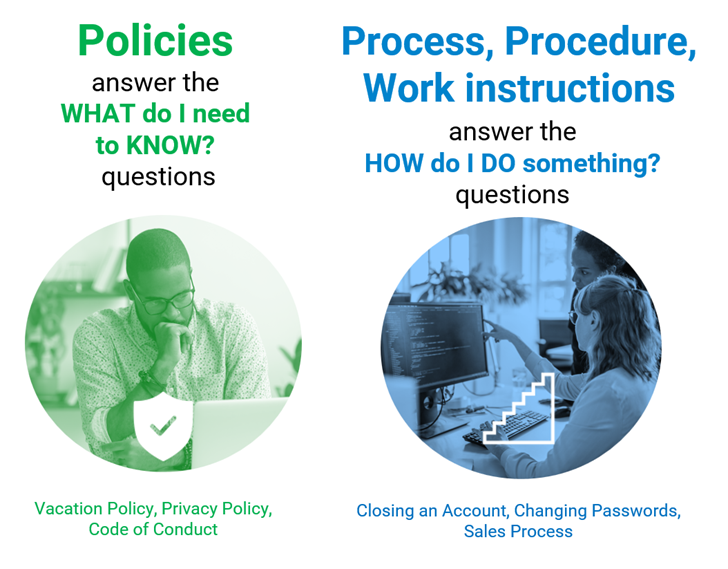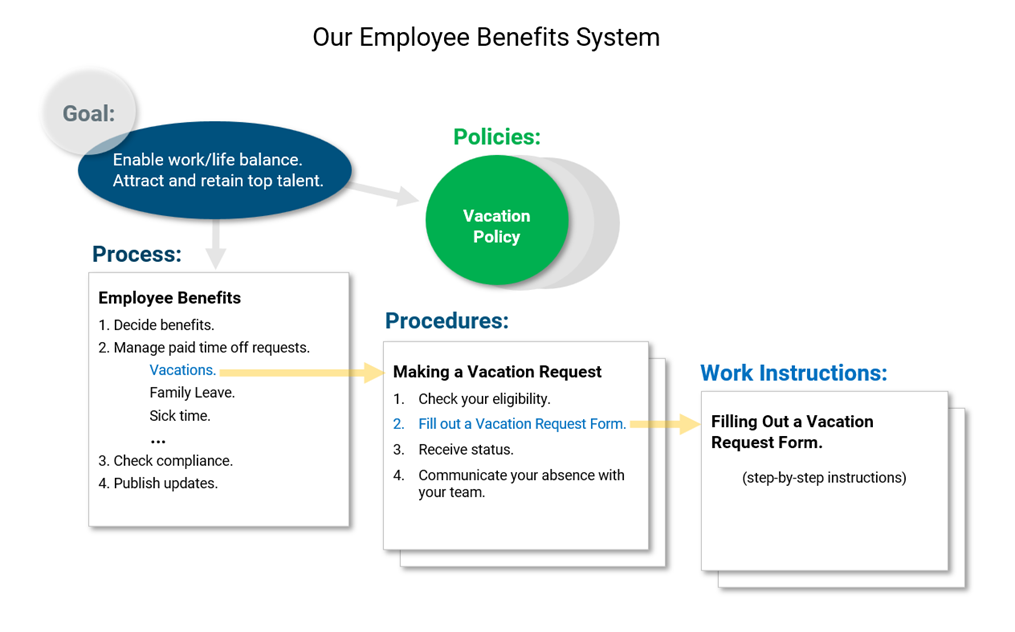
But despite best efforts, and hundreds of working hours, many organizations never achieve this goal. The documentation they are producing is confusing or never gets used. Everything is jumbled together because the content creators never really understood the difference between policy, process, procedure, and work instructions; they just started writing.
Why it matters
Understanding the difference between policy and process, procedures, and work instructions is critical for organizational performance. People have different questions and information needs. Senior management typically need the big picture, a manager may be looking for what the company policy is on a topic, while others may need “how-to” instructions or a specific set of rules.
When employees are forced to wade through pages and pages of operational documentation trying to decipher what applies to them, they get frustrated. Regulators and auditors who assess whether your policies and procedures conform to standards and laws hate to see policy mixed with the procedure in company procedures manuals and corporate training material.
Mixing these document types together also creates severe maintenance problems and opens the door to duplication errors. Case in point:
An organization in the banking industry had just been cited for a policy violation. Upon review of their content, we at Comprose noticed that a policy titled “Account Titling Guidelines” was written several different times in their documentation, and each time we encountered them, they were written differently. We advised our client to create one policy document and instead of duplicating the content, simply link the policy into relevant content. As a result, employees had a single source of truth. When the policy changed, the document owner simply had to update it in one spot. Anything it was linked to was automatically updated.
We know this can be difficult, but if you and your team can get clarity on these differences, the payoff is huge. Your employees will thank you. When employees have clear direction, their confidence goes up, operational efficiency is achieved, and compliance is enforced. And you’ll significantly reduce maintenance time, costs, and frustration.
Definitions and Best Practices for Policy, Process, Procedure, and Work Instructions
What is a Policy?
A policy is a set of general guidelines or statements of position regarding a given topic.
At its core, the purpose of policies is to offer a structured set of principles or rules crafted to guide decision-making and behavior. A single policy can contain several policy provisions, and policies do not contain steps.
Effective policies ensure that actions align with the overarching goals and values of the entity creating them. While policies are separate, they should be linked to processes, procedures, and work instructions.
Examples of a policy:
- Code of Conduct
- Employee Security
- Pricing Policy
- Approved Carriers
What is a Process?
A process is the high-level description of a large task or series of related tasks – it provides the “big picture” and strategic objectives for employees.
Operational processes answer the questions: how does a particular function or area of your business work, and what happens? Providing employees with this view helps them see how everyone works together and how their role fits in.
Examples of a process:
- Hiring Process
- Commercial Lending
- Sales Process
- Employee Benefits System
- QA Process
- LMS Development Process
What is a Procedure?
A procedure is a detailed and structured series of steps or actions that outlines how a specific task or process should be executed within an organization.
Sometimes referred to as a standard operating procedure (SOP), a procedure is more detailed than a process and includes best practices for each specific task, but procedures are not as detailed as work instructions. A procedure tells how a series of sequential tasks should be performed to achieve a desired outcome. A procedure answers the questions: what happens, in what order, who does what to whom, and how?
Examples of a procedure:
- Installing [name your application]
- Tracing a Lost Payment
- Submitting an Order
- Preparing a Proposal
- Planning a Webinar
- Lock Out Tag Out
What is a Work Instruction?
A work instruction is a document with detailed instructions that provides specific guidance and step-by-step instructions on how to perform a particular task or job.
Work instructions are the most detailed descriptions of a task, include best practices for each specific task, and are typically carried out by one person from start to finish in one sitting. Work instructions change more frequently than processes and procedures. They should be separate but linked to the other elements.
Examples of a work instruction:
- Changing Your Password
- Completing an Expense Report
- Running the Monthly Sales Report
Policy vs Tasks (Process, Procedure, Work Instruction)
Policy vs procedure may be the two terms that are most often confused – but they have key differences.
The content types used in any good system fall into these two main categories:
- A policy is a guideline, standard or statement of position; policies have no action. Use policy documents to answer the, “what do I need to know?” questions.
- Processes, procedures, work instructions are all tasks. The main difference is the level of detail. Use these content types to answer, “how do I do something?” questions.

Here’s an example most people can relate to:
Say you've been with a company for 9 months and want to see when you can take a vacation. To find your answer, you look up the company’s vacation policy. If you want to put in a vacation request, you can instantly jump to a related procedure that tells you how. That procedure might even have a link to a vacation request form that you can fill out and send to the HR Director.
Difference between process, procedure, work instruction
Before you start mapping out the actions for a task, stop and answer this question: how big of a job is it?
If it’s big, like “Employee Benefits,” it is typically a process. Processes often span across multiple departments and involve many people.
If it’s a detailed task, like “Completing a Vacation Time Request Form,” it’s a work instruction. Work instructions are tasks performed in one sitting from start to finish by one person.
Procedures are more detailed than processes, but not as detailed as work instructions.
Policy and Procedure: Why You Need Both
Creating policies without procedures and vice versa is a common mistake, especially when the focus is just on policy management.
Achieving business objectives requires that employees have access to both policies and procedures. Most regulations require both. Creating policies by themselves is a good start, but it’s equivalent to saying something like, “it is our policy to be an equal opportunity employer." It’s then up to the employees to figure out how to make that happen on their own. This is risky at best, and the end result can often be disastrous.
Avoid standalone procedures out of compliance or not synchronized with policies. “How-to” questions must get answered somehow. If your work procedures aren’t captured and cross-checked with stated policies, your organization will be inconsistent or even be noncompliant with legal, regulatory, or internal controls.
Mixing policy and procedure together in a single document
A common misconception – and this is held by many experts – is that there is a one-to-one correspondence between policy and procedure. In some cases, that’s true, but most of the time it is not! In real practice, a given policy may relate to multiple processes and procedures.
Hardwiring them together is old thinking and will create maintenance nightmares later. When a policy and procedure is in a single document, this makes it impossible to sort, track, or report just policies or just procedures. Content locked in a single document can’t be reused.
Are policies and procedures enough?
Some organizations stop at these two content types. They create policies and then everything else is procedure. We recommend you go a little further, keeping your audience in mind. Break out content and the type of document so it’s easy for your audience to find what is relevant to them.
How Policies and Processes, Procedures, and Work Instructions Fit Together
Using an example focused on Employee Benefits, the diagram below shows everything needed to carry out the process and how all the content pieces fit together. This framework accommodates the way people seek answers in daily situations, leading to faster, more accurate actions and better decisions. You have a system you can manage with, train from, and that regulators love.

The big picture process breaks down into multiple procedures and tasks. There are several policies pertaining to Employee Benefits. All of these content components work together as a system designed to achieve the goal: enabling an amazing Employee Benefits program.
Customize to your terminology
Keep in mind, the terminology you use may vary depending on industry standards. For example, instead of “procedure,” you may use the term protocol or SOP. Some people use the term desk procedure or job aid instead of work instruction. It doesn’t matter what you call these various content types as long as everyone understands their meaning and uses them consistently.
Discover a Better Policy and Procedure System
With Zavanta software, you can build an easy-to-understand information architecture for process improvement in any industry. You’ll experience writing support throughout your standard operating procedures documentation process via guided authoring, structured content, and content overlays. Track version control, approvals, and employee usage through the automation of the full life cycle of policy and procedure management.
Employees have the benefit of a superior user experience via a customized, branded employee portal and reader dashboard. They can quickly and easily access the most updated and relevant policy and procedure documents, and get back to their work.
By centralizing and standardizing your documentation processes through Zavanta, you not only mitigate risks associated with inconsistency but also empower your team with clear, accessible, and actionable guidelines.
Take the next step and unlock our Demo Hub. Go behind-the-scenes of Zavanta and click-through self-paced demos. See how Zavanta saves your authors time and frustration when writing policies and procedures. And see how we make content easily accessible to your employees through a branded portal and features like saving favorite documents.
Contact us today to start a conversation.
Additional Resources
- Avoiding Common Pitfalls: Don’t Mix up Policies and Procedures
- What’s the Right Level of Detail for Procedures and Work Instructions?
- What are Digital Work Instructions?
Unlock Instant Access!
Discover how Zavanta can slash author writing time and streamline your entire policy and procedure process. Empower your authors, ensure content is always within reach for your employees, and see the difference Zavanta can make.
Don’t wait—explore our Demo Hub now!
Please fill out the form below
.png?width=289&height=63&name=full%20logo%20(white).png)
